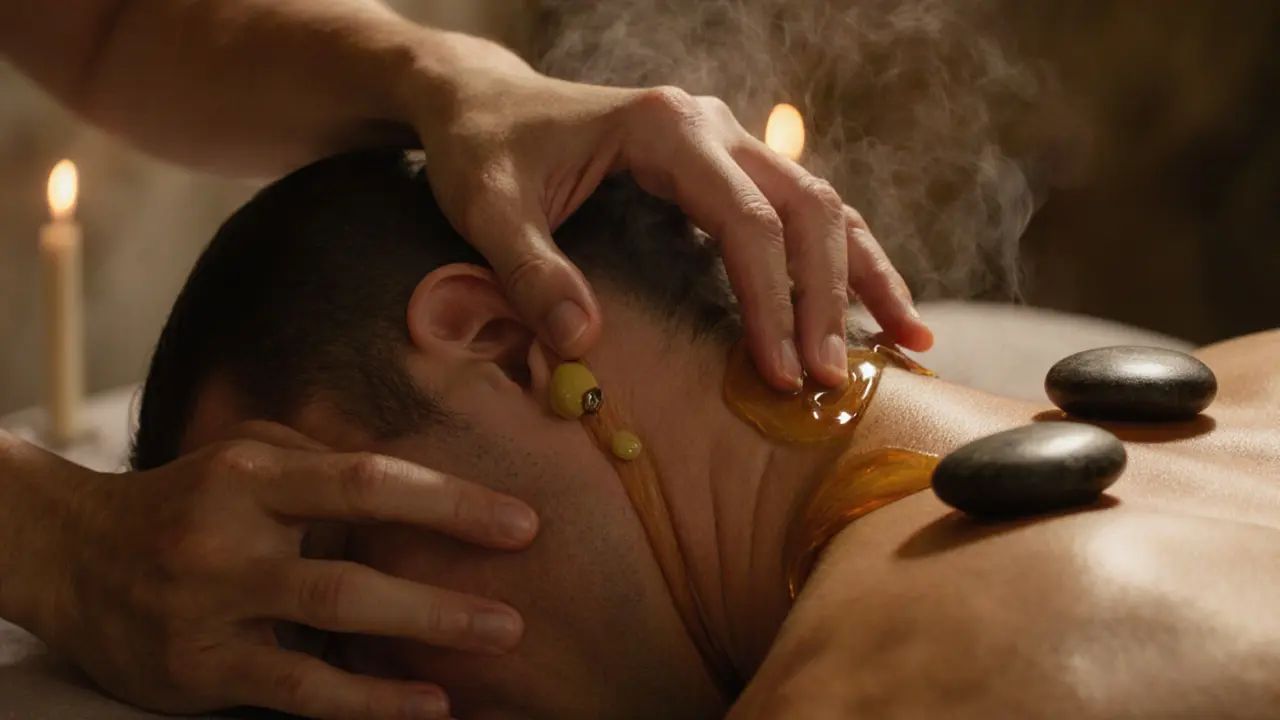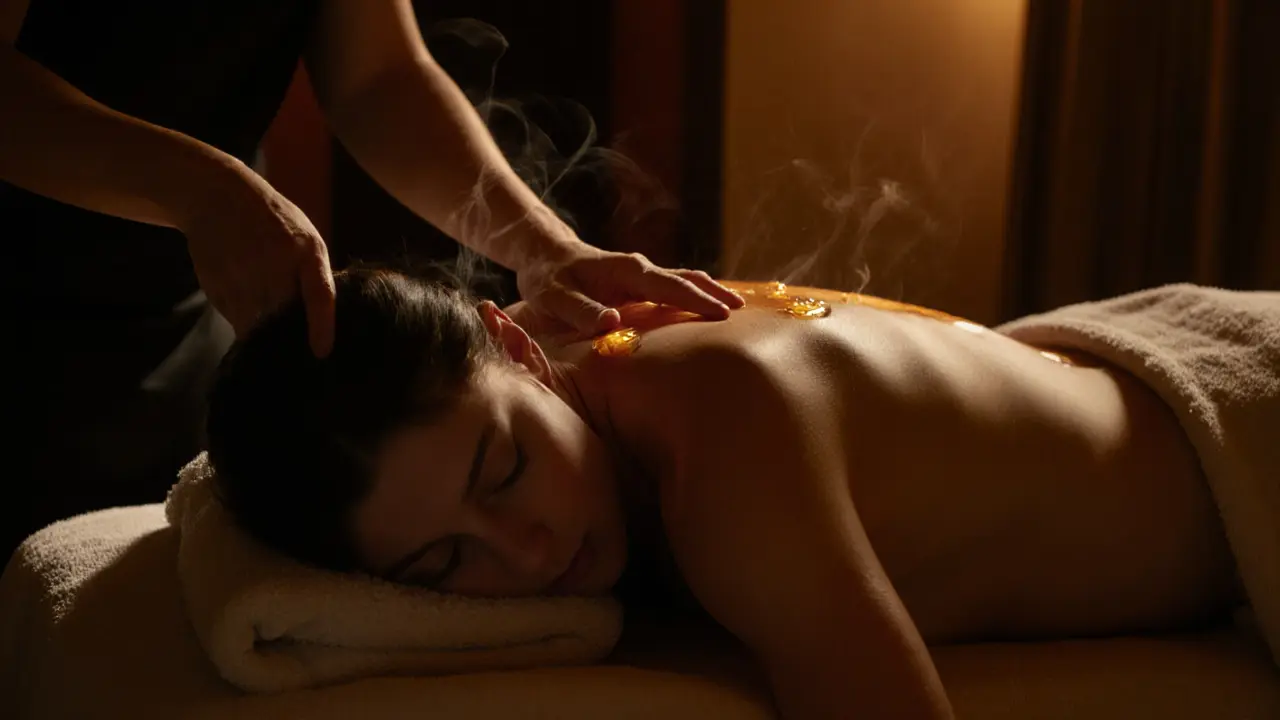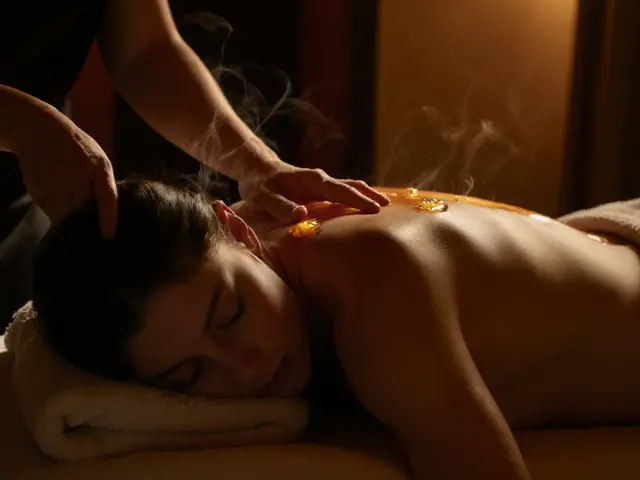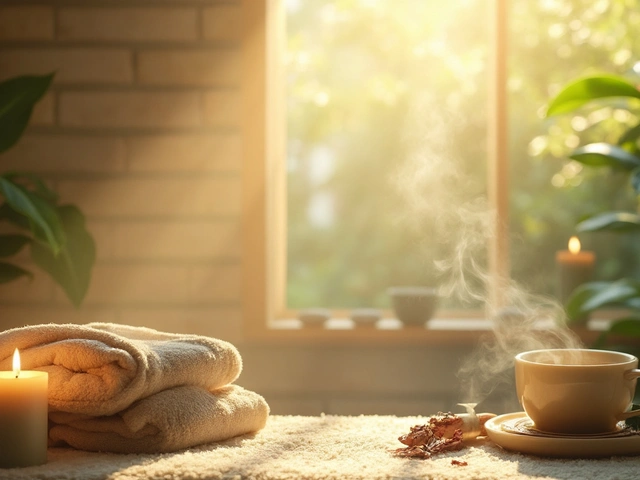You’ve been lying awake for hours. Your mind races. Your body feels tight. You’ve tried counting sheep, turning off your phone, even drinking chamomile tea-but nothing works. What if the answer isn’t in a pill or a fancy app, but in something as simple as a gentle touch?
What Is a Massage Relaxant?
A massage relaxant isn’t a product you buy off a shelf. It’s a technique. It’s the combination of slow, rhythmic pressure, warm hands, and intentional touch designed to calm your nervous system. Think of it as a reset button for your body. When you get a massage relaxant, you’re not just getting your shoulders rubbed-you’re telling your brain: It’s safe to unwind.
This isn’t just spa fluff. Studies from the Journal of Clinical Sleep Medicine show that people who received regular massage therapy reported falling asleep 30% faster and sleeping 20% longer than those who didn’t. The reason? Touch triggers the release of serotonin, which turns into melatonin-the hormone that tells your body it’s time to sleep.
Why Massage Relaxant Works for Sleep
Your body doesn’t sleep well when it’s stuck in fight-or-flight mode. Stress keeps cortisol high. Muscles stay clenched. Breathing stays shallow. A massage relaxant interrupts that cycle.
- It lowers cortisol by up to 31%, according to research from the University of Miami School of Medicine.
- It increases dopamine and serotonin-your brain’s natural calm chemicals.
- It reduces muscle tension that keeps you tossing and turning.
- It slows your heart rate and deepens your breath, signaling your body it’s time to rest.
One woman in Paris, Marie, started getting weekly massage relaxant sessions after her daughter was born. She’d been sleeping 3 hours a night. After six weeks, she was sleeping 6.5. "It wasn’t magic," she told me. "It was just my body finally remembering how to relax."
How It’s Different From Regular Massage
Not all massages are made equal. A Swedish massage might feel nice, but a massage relaxant is targeted. It’s slower. Deeper in the right places. Less about muscle knots, more about nervous system quiet.
Here’s how it’s done:
- Warm oil or lotion is applied-never cold.
- Pressure starts light, then builds just enough to feel grounding, not painful.
- The therapist avoids fast strokes. Everything is slow, deliberate.
- Focus areas: back of the neck, shoulders, feet, and scalp-places where stress hides.
- Room is quiet, dim, and warm. No music with beats. Just soft ambient tones.
This isn’t a 20-minute quick fix. It’s a 60- to 90-minute reset. And it’s designed to make your body feel like it’s sinking into a warm bath-except it’s your skin, your muscles, your mind.
What to Expect During a Session
You’ll lie face down on a padded table, covered with a soft towel. The room smells like lavender or sandalwood-nothing overpowering. The therapist will begin at your feet, using long, gliding strokes. You might feel a slight pressure on your lower back, but it won’t hurt. It’ll feel like a heavy blanket being placed over your shoulders.
As the session goes on, you’ll notice your breathing slowing. Your jaw unclenches. Your fingers relax. You might drift off. That’s not a failure-it’s the goal.
Afterward, you won’t feel buzzed or energized. You’ll feel soft. Heavy. Quiet. That’s the signal your nervous system is finally turning off the alarms.

Types of Massage Relaxant Techniques
There are a few styles that work best for sleep:
- Swedish Massage with Slow Rhythm-long strokes, gentle kneading. Perfect for beginners.
- Thai Massage (Gentle Version)-uses passive stretching. Helps release deep tension.
- Reflexology-focused pressure on the feet. Proven to reduce insomnia in older adults.
- Head and Neck Massage-targets the occipital ridge and trapezius muscles. Instant calm.
- Hot Stone Massage-warm stones placed along the spine. Deeply soothing for chronic stress.
Most places in Paris offer a "Sleep-Focused Massage" package. Ask for "slow, quiet, no talking"-that’s the key.
Where to Find Massage Relaxant Services in Paris
You don’t need to go to a luxury spa. Some of the best massage relaxant sessions happen in quiet studios tucked into the 11th or 14th arrondissements.
Look for places that say:
- "Sleep Therapy" or "Calm Massage"
- "No music" or "Silent sessions available"
- "For stress relief and insomnia"
Try La Maison du Repos in Le Marais. Or Le Jardin du Sommeil near Montparnasse. Both specialize in sleep-focused massage. Book a 75-minute session. Don’t rush it.
Pricing and Booking
A single massage relaxant session in Paris costs between €65 and €110, depending on location and duration. Most places offer:
- 60 minutes: €65-€80
- 75 minutes: €85-€95
- 90 minutes: €100-€110
Book online or call ahead. Tell them you’re looking for a "sleep massage"-not a "relaxation massage." The difference matters. Ask if they use warm oil, dim lighting, and silence. If they say "yes," you’ve found the right place.

Safety Tips
Massage relaxant is safe for most people. But avoid it if:
- You have open wounds or recent injuries.
- You’re pregnant without clearance from your doctor.
- You have severe osteoporosis or blood clotting issues.
Always tell your therapist about any health conditions. And if you feel dizzy, nauseous, or in pain during the session-speak up. Good therapists expect it.
Massage Relaxant vs. Sleep Medication
| Aspect | Massage Relaxant | Sleep Medication |
|---|---|---|
| How it works | Calms the nervous system naturally | Suppresses brain activity |
| Time to feel effect | After 1-2 sessions | Within 30 minutes |
| Side effects | None | Drowsiness, dependency, memory issues |
| Long-term use | Safe and encouraged | Not recommended beyond 2 weeks |
| Cost per month (4 sessions) | €260-€440 | €50-€150 (but risk of addiction) |
Medication gives you sleep. Massage gives you the ability to sleep again-on your own.
Frequently Asked Questions
Can massage relaxant help with insomnia?
Yes. Multiple studies, including one from the National Institutes of Health, show that people with chronic insomnia who received weekly massage therapy improved their sleep quality by 40% over 8 weeks. It doesn’t work overnight, but after 3-4 sessions, most people notice a real shift.
How often should I get a massage relaxant for sleep?
Start with once a week for 4 weeks. After that, you can drop to every other week. Think of it like brushing your teeth-you don’t need to do it daily to stay healthy, but regular maintenance keeps things balanced.
Can I do massage relaxant at home?
You can try. Use warm oil, slow strokes on your neck and feet, and dim lights. But it’s hard to replicate the deep calm of a trained therapist. Your own hands can’t fully relax your body the way someone else’s can. Save home routines for maintenance-use professional sessions for reset.
Does massage relaxant work for men too?
Absolutely. Men are just as affected by stress and poor sleep as women. In fact, men are less likely to seek help-making massage relaxant an even more valuable tool. Many male clients in Paris report better sleep, lower anxiety, and even improved focus at work after starting sessions.
What if I don’t feel relaxed during the session?
It’s normal. If your mind is racing, don’t fight it. Just notice it. The therapist knows. They’re not expecting you to be zen. They’re just helping your body remember how to rest. Often, the second or third session is when the real shift happens.
Ready to Sleep Again?
You don’t need another pill. You don’t need another app. You just need to let someone else hold your stress for an hour. That’s all. Let your body remember what calm feels like. Book your session. Lie down. Breathe. And for the first time in weeks-let yourself fall asleep.










Keenan Blake
November 7, 2025 AT 01:49I’ve been experimenting with this for about a month now-weekly 75-minute sessions at a studio in Brooklyn. Honestly, I didn’t expect much, but after the third time, I actually woke up before my alarm for the first time in years. No caffeine, no alarms jolting me. Just… quiet. My partner even noticed I stopped sighing in my sleep. Weird, right? But it works.
Sylvain Menard
November 7, 2025 AT 21:31THIS. THIS IS THE SHIT. I used to take melatonin like candy until my brain forgot how to make its own. Then I tried a ‘sleep massage’ in Vancouver-no music, warm stones, therapist didn’t say a word. I cried halfway through. Not because it hurt-because my body finally remembered how to let go. Do it. Now. Your future self will thank you.
Sophia Sterling-Angus
November 9, 2025 AT 18:00Let’s be real-the ‘studies’ cited here are either tiny sample sizes or funded by spa chains. The Journal of Clinical Sleep Medicine? They published a 12-person pilot study last year. And ‘cortisol drops 31%’? That’s from a single 2018 trial with no control group. Also, reflexology for insomnia? That’s pseudoscience wrapped in lavender oil. Don’t get me wrong-I love a good massage-but don’t sell it as medicine.
Madi Edwards
November 10, 2025 AT 21:32You know what’s wild? I used to think massage was just for people who could afford to sit around and be pampered. Then my dad got diagnosed with stage 3 anxiety-he’s 68, retired, never talked about feelings. Last Christmas, I bought him a 90-minute sleep massage as a gift. He cried when he came back. Said he hadn’t slept through the night since 2015. Now he goes every other week. He doesn’t call it therapy. He calls it ‘my quiet hour.’ And honestly? I think that’s the most powerful thing I’ve ever seen. We don’t need to fix everything. Sometimes we just need to be held.
Kelly ¯_(ツ)_/¯
November 11, 2025 AT 01:59As someone who grew up in a culture where touch was either forbidden or sexualized, this article hit differently. My grandmother used to rub my feet with coconut oil before bed-no words, just pressure. I didn’t realize until now that she was giving me a massage relaxant before the term existed. This isn’t luxury. It’s ancestral. And it’s time we stop treating healing touch as optional.
Amanda turman
November 11, 2025 AT 06:00Okay but what if you’re just… emotionally constipated? Like, your body is fine but your soul is stuck in a 2017 breakup? Can massage fix that? I mean, I cried during my first one and then spent the next 3 days in bed rewatching Grey’s Anatomy. Is that progress? Or am I just projecting? I think my therapist knew. She didn’t say anything. Just kept massaging my temples. I think she’s a witch. Or a saint. Either way, I’m going back. Even if it’s just to feel something besides numb.
Casey Brown
November 12, 2025 AT 08:11To everyone who’s skeptical-try it once. No expectations. Just lie down. Let someone else hold your weight for an hour. You don’t have to believe in it. You just have to show up. And if it doesn’t change your sleep? At least you got a really nice hour of quiet in a world that never stops screaming. You deserve that.